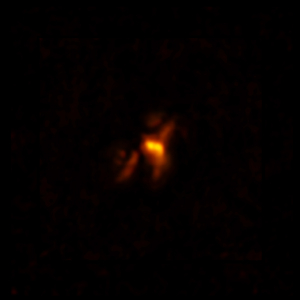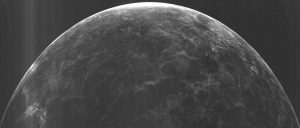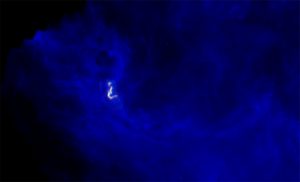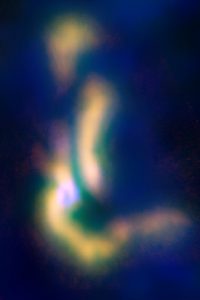Composite image showing how powerful radio jets from the supermassive black hole at the center of a galaxy in the Phoenix Cluster inflated huge “bubbles” in the hot, ionized gas surrounding the galaxy (the cavities inside the blue region imaged by NASA’s Chandra X-ray observatory). Hugging the outside of these bubbles, ALMA discovered an unexpected trove of cold gas, the fuel for star formation (red). The background image is from the Hubble Space Telescope.


ALMA Sees Into the Heart of the Phoenix Cluster
ALMA image of cold molecular gas at the heart of the Phoenix Cluster. The filaments extending from the center hug enormous radio bubbles created by jets from a supermassive black hole. This discovery sheds light on the complex relationship between a supermassive black hole and its host galaxy.

Arecibo-GBT Image of Venus
This is a radar image of the planet Venus made by transmitting a signal at 13 cm wavelength from Arecibo and using the GBT to detect the reflection off its surface. Brighter parts of the image indicate a rougher surface, while dark regions are smoother (on centimeter to meter scales). Many features, including mountain ranges, volcanic domes, and craters can be seen. The resolution of this image varies from 1 to 5 km. Investigator(s): Donald Campbell, Jean-Luc Margot, Lynn Carter, and Bruce Campbell

Stars Forming Together in Barnard 5
The B5 complex (red and green; radio images taken with the VLA and GBT) seen within its neighborhood, embedded in dust (blue) as seen with ESA’s Herschel Space Observatory, in infrared light.

A Multiple-Star System Forms in Barnard 5
The Barnard 5 complex of gas is in the process of becoming a multiple-star system. B5 is a molecular cloud located in the constellation Perseus, approximately 800 light-years away. It contains one young protostar and three dense condensations that astronomers say will collapse into stars in the astronomically-short period of 40,000 years. Astronomers discovered that filaments of gas in the cloud are fragmenting, and the fragments are beginning to form into additional stars that will become a multiple-star system.

Composite image of the barred spiral galaxy NGC 1097, including images from ALMA and HST
Composite image of the barred spiral galaxy NGC 1097. By studying the motion of two molecules, ALMA was able to determine that the supermassive black hole at the galactic center has a mass 140 million times greater than our Sun. The ALMA data is in red (HCO+) and green/orange (HCN) superimposed on an optical image taken by the Hubble Space Telescope.





